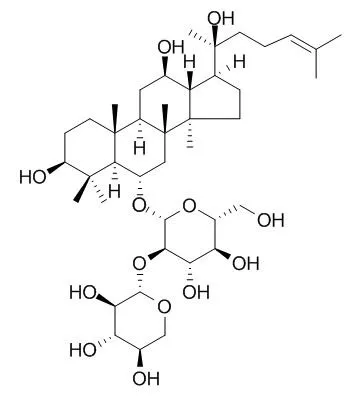6-Hydroxydopamine (6-OHDA) is known to contribute to neuronal death in Parkinson's disease.
METHODS AND RESULTS:
In this study, we found that the preincubation of SH-SY5Y cells for 24 h with 20 μ M Notoginsenoside R2 (NGR2), which is a newly isolated notoginsenoside from Panax notoginseng, showed neuroprotective effects against 6-OHDA-induced oxidative stress and apoptosis. NGR2 incubation successively resulted in the activation of P90RSK, inactivation of BAD, and inhibition of 6-OHDA-induced mitochondrial membrane depolarization, thus preventing the mitochondrial apoptosis pathway. NGR2 incubation also led to the activation of Nrf2 and subsequent activity enhancement of phase II detoxifying enzymes, thus suppressing 6-OHDA-induced oxidative stress, and these effects could be removed by Nrf2 siRNA. We also found that the upstream activators of P90RSK and Nrf2 were the MEK1/2-ERK1/2 pathways but not the JNK, P38, or PI3K/Akt pathways. Interestingly, NGR2 incubation could also activate MEK1/2 and ERK1/2. Most importantly, NGR2-mediated P90RSK and Nrf2 activation, respective downstream target activation, and neuroprotection were reversed by the genetic silencing of MEK1/2 and ERK1/2 by using siRNA and PD98059 application.
CONCLUSIONS:
These results suggested that the neuroprotection elicited by NGR2 against 6-OHDA-induced neurotoxicity was associated with NGR2-mediated P90RSK and Nrf2 activation through MEK1/2-ERK1/2 pathways. |






 Cell. 2018 Jan 11;172(1-2):249-261.e12. doi: 10.1016/j.cell.2017.12.019.IF=36.216(2019)
Cell. 2018 Jan 11;172(1-2):249-261.e12. doi: 10.1016/j.cell.2017.12.019.IF=36.216(2019) Cell Metab. 2020 Mar 3;31(3):534-548.e5. doi: 10.1016/j.cmet.2020.01.002.IF=22.415(2019)
Cell Metab. 2020 Mar 3;31(3):534-548.e5. doi: 10.1016/j.cmet.2020.01.002.IF=22.415(2019) Mol Cell. 2017 Nov 16;68(4):673-685.e6. doi: 10.1016/j.molcel.2017.10.022.IF=14.548(2019)
Mol Cell. 2017 Nov 16;68(4):673-685.e6. doi: 10.1016/j.molcel.2017.10.022.IF=14.548(2019)